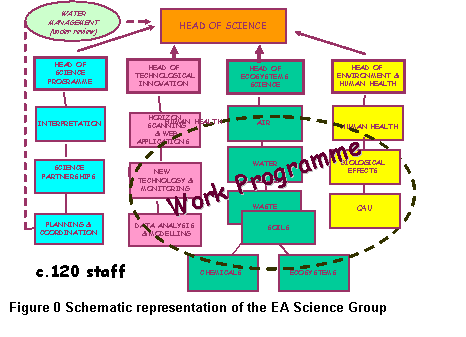
WASTEWATER RESEARCH AND INDUSTRY SUPPORT FORUM
Meeting 24th September 2004
Please note that for older reports some links will be to sites that are no longer active.
This was the Forum’s 25th meeting; it welcomed guest speakers Prof. Charles Tyler and Bob Harris.
Caryll Stephen told the Forum that, following research into the need for such an initiative, FWR has just approved spending £¼ million to establish and provide, for 12 months, a “one stop shop” for Article 14 of the WFD, i.e. that which demands public consultation. Defra and the EA have agreed they might continue the funding if FWR’s initiative proves useful.
The report of the latest FWR/WaPUG workshop, which was supported by the Forum, is on this website under publications. It was the most difficult to date because there are so many facets to the subject of urban run-off, not least because of the uncertainties that climate change is bringing to the situation. To some extent it was complemented by a workshop organised by UKCIP (UK Climate Impacts Programme www.ukcip.org.uk) on the subject of high resolution rainfall data. To date the drainage operators have not been allowed to factor climate change into their business plans which, since they are building assets with an expected life of more than 100 years, seems questionable; if they were allowed, the financial consequences would surely motivate co-ordination of the various agencies that could contribute to cost effective solutions. Members were encouraged to read and respond to the Defra consultation “Making space for water” the closing date for responses for which is Monday 1st November 2004 .
The Forum discussed the subject of feminisation of fishes and endocrine active substances (EAS) with Prof. Charles Tyler of Exeter University, a leading expert on the subject. The UK has been in the vanguard on this research area but the problem is not uniquely British. Work started in about 1986 when male fishes were found to produce female hormone downstream of STW discharges. There is now a convincing body of evidence from placing caged rainbow trout in rivers and effluent and from catching wild roach that the treated water from wastewater treatment works (sewage works’ effluent) is implicated in this feminising effect. The effect is more pronounced the longer the fishes are exposed and the greater the concentration of effluent that is in the water. The active substances are natural and synthetic female hormones plus some chemicals in wastewater from textile factories. But, no effect has been observed on the populations of wild fish in affected waters: it has not possible to assess if wild populations of roach are being adversely impacted by endocrine disruption. It is quite possible that unfeminised males invade the affected reaches and fertilise eggs during spawning time and it is this which maintains populations; one effect of feminisation is that affected males lose their competitive instinct to reproduce so they would tolerate being displaced. The wastewater treatment processes are known to degrade the EAS but to date there is not sufficient information to know how the processes could be managed/adjusted to maximise degradation to defined limits. In addition effective concentrations are near to the limits of detection by instrumental analysis, which means that if there were to be discharge limits they could not be verified. Tertiary treatment by activated carbon is impractical because the overwhelming amount of other compounds in effluent would inactivate the carbon quickly and the carbon-cost (greenhouse gas emission) of regeneration would be disproportionate. Whilst it appears irrefutable that there is an effect on male fishes downstream of some (but not all) wastewater treatment works, calculating the environmental cost-benefit of treating it appears problematic, especially if fish populations are unaffected.
Bob Harris, Head of Ecosystem Science at the Environment Agency described its New Science Structure and Research Approach. EA science and research is in middle of long-term change process which will be set out in a strategy document - “Solving Environmental Problems using Scientific Knowledge” to be published in October. There will be Agency-wide coordination of science; with fewer small projects, more “delivery focussed” programmes; and greater engagement with the UK environmental science community through a new “Environmental Research Funders’ Forum to co-ordinate activity. The human and financial resource allocated to the EA’s Science Group is about 1% of the total.

The AMP process has been effective at removing point sources of pollution to water; the challenge now for the EA is to deal with diffuse sources and the so-called “mega-sites”. This will mean a change from point-source-regulation to regulating the environment as a whole. This will affect people/publics [there are several publics] rather than sites/industries; the socio-economic dimension is important but we have to understand the processes first before we can engineer solutionsand we need to be certain before we instruct/initiate these changes, such as changing larges areas of farming in East Anglia, that they are appropriate. The Water Framework Directive (WFD) is using the river as an integrator for the whole catchment. We have to understand how river basins work. The river basins are defined but they will have to be broken down into catchments for management and aggregated for reporting to Brussels. [Hopefully we shall not use the WFD as a reason for spending £ millions on EAS in effluents without finding out whether it is individuals or fish populations that are impacted and doing a thorough cost-benefit assessment.]
Bob said his vision is that by 2010 a systematic approach to understanding water flow, pollutant flux and pathway transformation within and between environmental compartments in river basins will have been developed and adopted. This will underpin a systemised modelling approach to the management of land use in river basins. The understanding of fluxes and fate and transport of pollutants will have been applied to our knowledge of aquatic (and terrestrial) ecosystems in order to develop and implement land use management strategies which achieve good water body status.